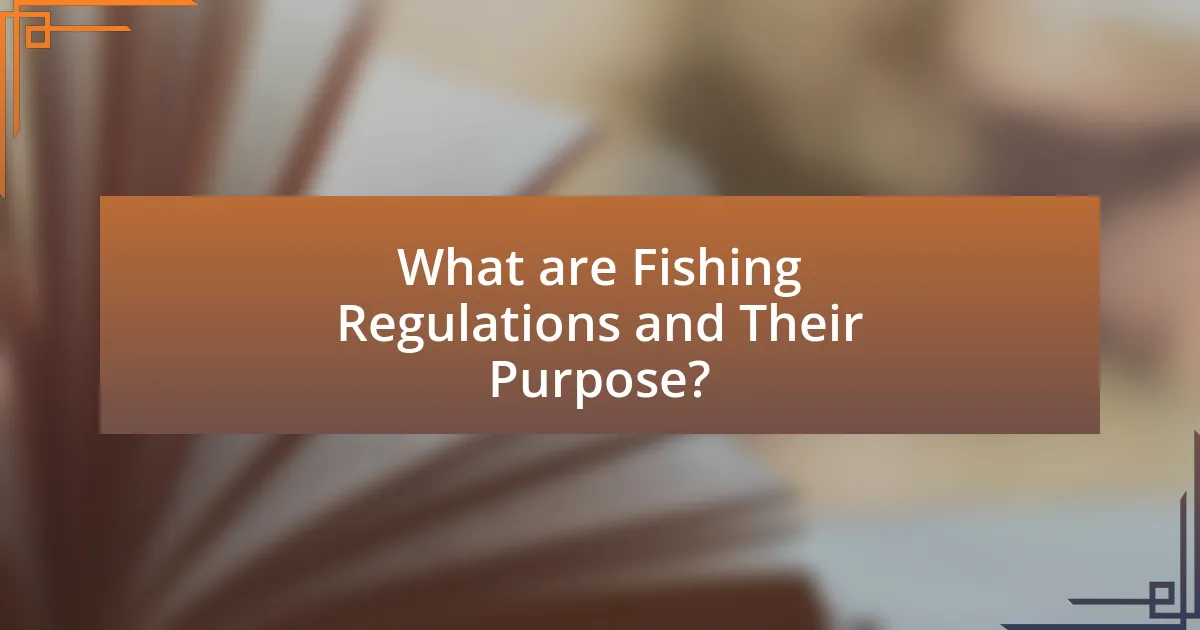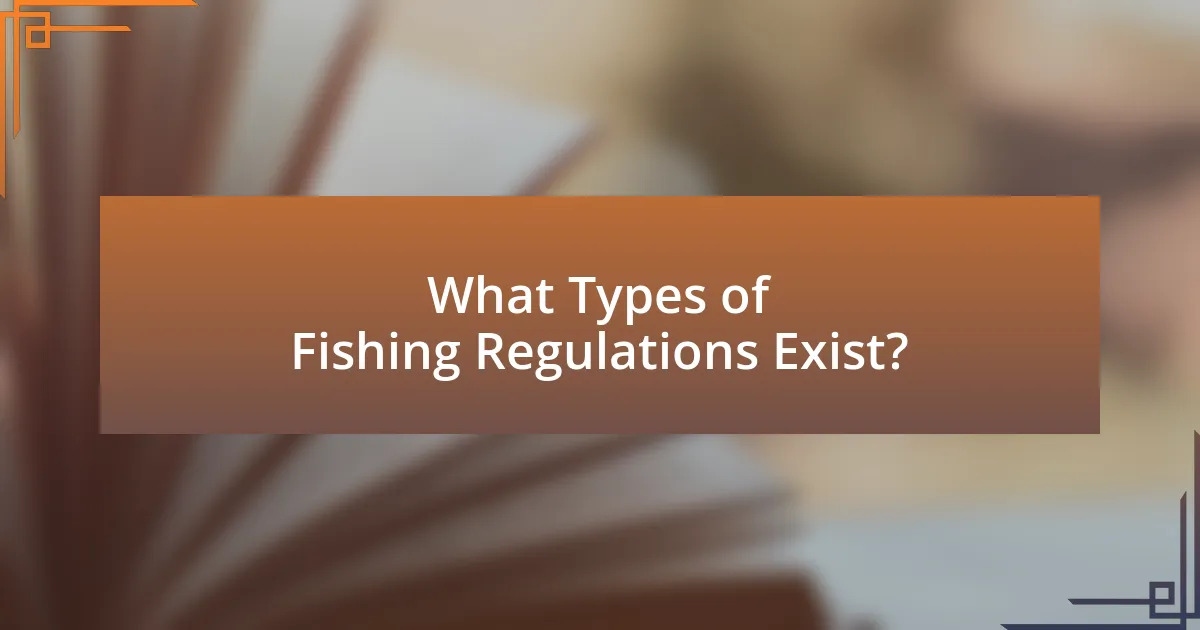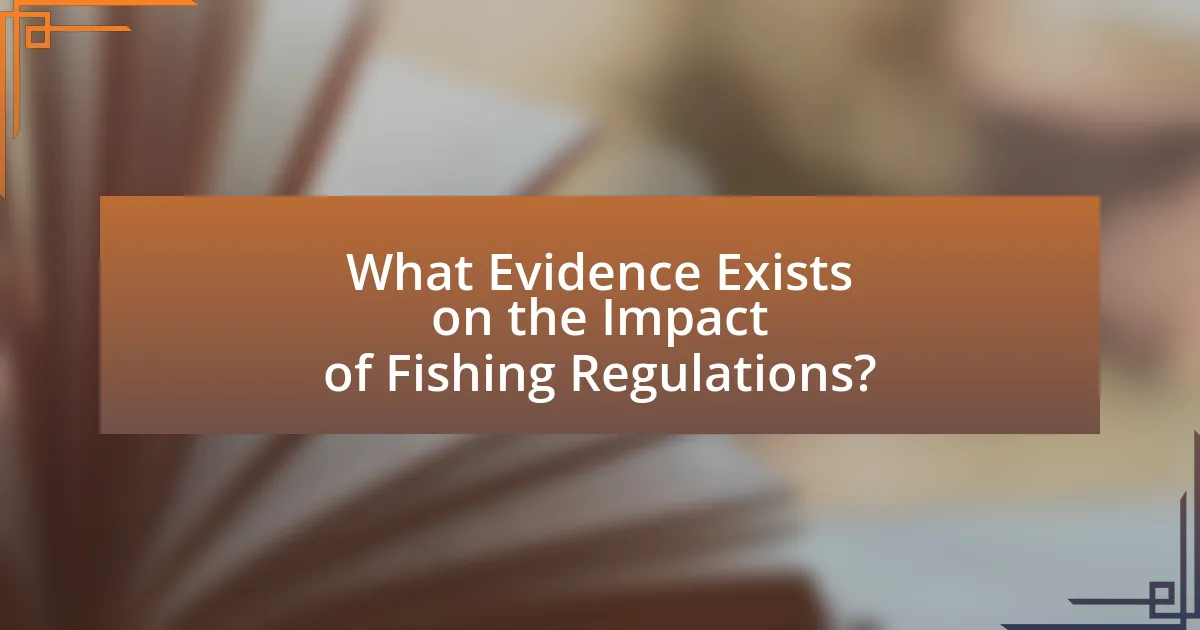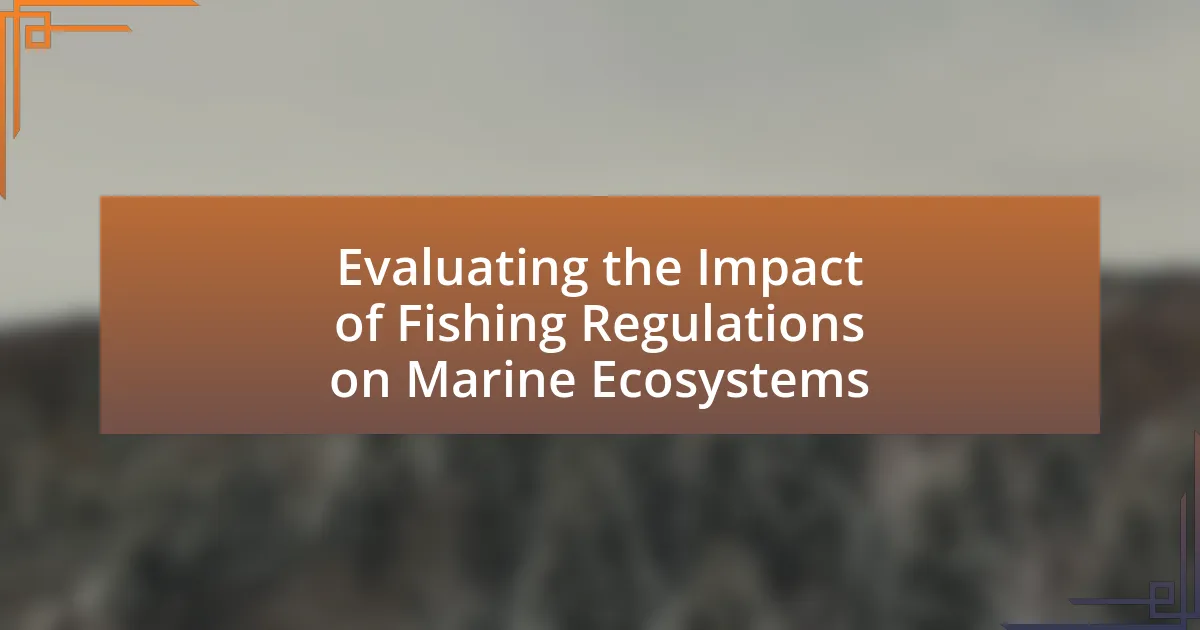Fishing regulations are legal guidelines designed to manage fish populations and protect aquatic ecosystems, ensuring sustainable fishing practices and preventing overfishing. This article evaluates the impact of these regulations on marine ecosystems, detailing how they influence fish populations, biodiversity, and habitat health. It discusses various types of regulations, such as catch limits and seasonal closures, and their effectiveness in promoting recovery of overfished species and maintaining ecological balance. Additionally, the article highlights the economic implications of these regulations for local fishing communities and emphasizes the importance of stakeholder engagement and scientific research in shaping effective fishing policies.

What are Fishing Regulations and Their Purpose?
Fishing regulations are legal guidelines established to manage and protect fish populations and aquatic ecosystems. Their primary purpose is to ensure sustainable fishing practices, prevent overfishing, and maintain biodiversity within marine environments. For instance, regulations may include limits on catch sizes, seasonal closures, and restrictions on specific fishing methods, all aimed at preserving fish stocks and their habitats. According to the National Oceanic and Atmospheric Administration (NOAA), effective fishing regulations have been shown to lead to the recovery of overfished species, demonstrating their critical role in marine conservation efforts.
How do fishing regulations impact marine ecosystems?
Fishing regulations significantly impact marine ecosystems by controlling fish populations and promoting biodiversity. These regulations, such as catch limits and seasonal closures, help prevent overfishing, which can lead to the depletion of key species and disrupt food webs. For instance, studies have shown that areas with strict fishing regulations experience higher biomass and diversity of marine life, as seen in the Gulf of California, where no-take zones led to a 400% increase in fish biomass over a decade. Additionally, effective regulations can aid in the recovery of endangered species, contributing to the overall health of marine ecosystems.
What specific aspects of marine ecosystems are affected by fishing regulations?
Fishing regulations specifically affect fish populations, biodiversity, habitat health, and ecosystem balance within marine ecosystems. These regulations, such as catch limits and seasonal closures, aim to prevent overfishing, which can lead to population declines and disrupt food webs. For instance, studies have shown that implementing size limits can help maintain sustainable fish stocks, thereby supporting the overall health of marine environments. Additionally, regulations that protect critical habitats, like spawning areas, contribute to the resilience of marine ecosystems by ensuring that diverse species can thrive and reproduce effectively.
How do fishing regulations influence fish populations?
Fishing regulations significantly influence fish populations by controlling the amount and type of fish that can be harvested. These regulations, such as catch limits, size limits, and seasonal closures, are designed to prevent overfishing and allow fish stocks to recover. For example, studies have shown that areas with strict regulations, like no-take marine reserves, can experience a 600% increase in fish biomass compared to unregulated areas. This increase supports not only the targeted species but also enhances the overall biodiversity of the marine ecosystem.
Why are fishing regulations necessary for sustainable fishing?
Fishing regulations are necessary for sustainable fishing because they help maintain fish populations and protect marine ecosystems. These regulations set limits on catch sizes, fishing seasons, and methods, which prevent overfishing and allow fish stocks to replenish. For instance, according to the Food and Agriculture Organization, approximately 34% of global fish stocks are overfished, highlighting the need for regulations to ensure long-term viability. By enforcing these rules, fisheries can promote biodiversity and ecosystem health, ultimately supporting the livelihoods of communities that depend on fishing.
What are the ecological consequences of unregulated fishing?
Unregulated fishing leads to significant ecological consequences, including the depletion of fish populations and disruption of marine ecosystems. Overfishing can result in the collapse of key species, which affects the entire food web, as seen in the case of Atlantic cod, where populations plummeted by over 90% due to unregulated catches. This depletion not only threatens the survival of targeted species but also impacts predator species that rely on them for food, leading to imbalances in marine biodiversity. Furthermore, unregulated fishing practices, such as bottom trawling, cause habitat destruction, damaging sensitive ecosystems like coral reefs and seafloor habitats, which are crucial for maintaining marine life. The loss of biodiversity and habitat integrity ultimately undermines the resilience of marine ecosystems, making them more vulnerable to other stressors such as climate change.
How do fishing regulations contribute to biodiversity conservation?
Fishing regulations contribute to biodiversity conservation by establishing limits on catch sizes, seasons, and methods, which help prevent overfishing and protect vulnerable species. These regulations are designed to maintain fish populations at sustainable levels, ensuring that ecosystems remain balanced. For instance, the implementation of marine protected areas (MPAs) has been shown to increase species diversity and abundance, as evidenced by a study published in “Nature” by Edgar et al. (2014), which found that MPAs can lead to a 446% increase in fish biomass. By regulating fishing practices, authorities can mitigate the negative impacts of fishing on marine biodiversity, allowing ecosystems to recover and thrive.

What Types of Fishing Regulations Exist?
Fishing regulations primarily include size limits, bag limits, seasonal closures, gear restrictions, and area restrictions. Size limits dictate the minimum or maximum size of fish that can be legally caught, ensuring juvenile fish can mature and reproduce. Bag limits restrict the number of fish an angler can keep in a single day, helping to prevent overfishing. Seasonal closures are implemented to protect fish during spawning periods, allowing populations to recover. Gear restrictions specify the types of equipment that can be used, aiming to minimize bycatch and habitat damage. Area restrictions designate specific regions where fishing is prohibited or limited, often to protect sensitive ecosystems or endangered species. These regulations are enforced to maintain sustainable fish populations and protect marine ecosystems.
How do catch limits function within fishing regulations?
Catch limits function within fishing regulations by establishing a maximum quantity of fish that can be harvested within a specific time frame to ensure sustainable fish populations. These limits are set based on scientific assessments of fish stocks, which consider factors such as population size, reproductive rates, and ecosystem health. For example, the National Oceanic and Atmospheric Administration (NOAA) uses data from fishery surveys and models to determine annual catch limits, aiming to prevent overfishing and promote recovery of depleted stocks. This regulatory approach helps maintain ecological balance and supports the long-term viability of marine ecosystems.
What are the benefits of implementing catch limits?
Implementing catch limits benefits marine ecosystems by promoting sustainable fish populations and preventing overfishing. These limits help maintain the balance of marine biodiversity, ensuring that various species can thrive and reproduce. For instance, studies show that regions with catch limits experience a 20% increase in fish biomass over five years, which supports healthier ecosystems and enhances resilience against environmental changes. Additionally, catch limits contribute to the economic stability of fishing communities by ensuring long-term access to fish stocks, thereby securing livelihoods and promoting responsible fishing practices.
How do catch limits vary across different regions?
Catch limits vary significantly across different regions due to local fish populations, environmental conditions, and regulatory frameworks. For instance, the North Atlantic has stricter catch limits for species like cod, set by organizations such as the Northwest Atlantic Fisheries Organization, to prevent overfishing, while the Pacific region may have more flexible limits based on species abundance and ecosystem assessments. These variations are often informed by scientific research, such as the assessments conducted by the International Council for the Exploration of the Sea, which provide data on fish stocks and sustainability, influencing regional regulations.
What role do seasonal closures play in fishing regulations?
Seasonal closures play a critical role in fishing regulations by allowing fish populations to reproduce and recover during specific times of the year. These closures are implemented to prevent overfishing and ensure sustainable fish stocks, which is essential for maintaining healthy marine ecosystems. For instance, studies have shown that seasonal closures can lead to significant increases in fish biomass and diversity, as observed in the Gulf of Mexico, where closures during spawning seasons resulted in a 30% increase in fish populations over five years. This evidence supports the effectiveness of seasonal closures in promoting long-term ecological balance and fishery sustainability.
How do seasonal closures affect breeding cycles of marine species?
Seasonal closures positively affect the breeding cycles of marine species by providing a refuge during critical reproductive periods. These closures reduce fishing pressure, allowing populations to spawn and grow without the stress of harvesting. For instance, studies have shown that areas with seasonal closures exhibit increased reproductive success and higher juvenile recruitment rates, as seen in species like the Atlantic cod, which benefits from designated spawning seasons free from fishing activities. This evidence supports the notion that well-implemented seasonal closures can enhance the sustainability of marine ecosystems by promoting the recovery and stability of fish populations.
What are the challenges of enforcing seasonal closures?
Enforcing seasonal closures presents several challenges, primarily due to compliance monitoring and enforcement resource limitations. Authorities often struggle to effectively monitor vast marine areas, making it difficult to ensure that all fishers adhere to the closures. Additionally, illegal fishing activities can undermine the effectiveness of these regulations, as offenders may operate covertly during closed seasons. Furthermore, the socio-economic impact on local fishing communities can lead to resistance against closures, complicating enforcement efforts. Studies indicate that without adequate resources and community engagement, the success of seasonal closures in protecting marine ecosystems is significantly diminished.

What Evidence Exists on the Impact of Fishing Regulations?
Evidence indicates that fishing regulations significantly improve fish populations and marine ecosystems. Studies show that areas with strict regulations, such as marine protected areas (MPAs), experience higher biomass and biodiversity. For instance, a meta-analysis published in “Nature” by Edgar et al. (2014) found that MPAs can lead to a 446% increase in fish biomass compared to unprotected areas. Additionally, regulations like size limits and catch quotas have been shown to enhance the sustainability of fisheries, as evidenced by the recovery of overfished stocks in regions like the North Atlantic, where the implementation of catch limits led to a 30% increase in cod populations over a decade. These findings underscore the effectiveness of fishing regulations in promoting healthier marine ecosystems.
How have fishing regulations changed fish populations over time?
Fishing regulations have significantly altered fish populations over time by promoting sustainable practices that prevent overfishing. For instance, the implementation of size limits, catch quotas, and seasonal closures has allowed fish stocks to recover and maintain healthy population levels. A study by the National Oceanic and Atmospheric Administration (NOAA) found that from 2000 to 2018, the biomass of overfished stocks in U.S. waters increased by 50%, demonstrating the effectiveness of these regulations in rebuilding fish populations. Additionally, the establishment of marine protected areas (MPAs) has further contributed to the recovery of various species by providing safe habitats free from fishing pressure.
What case studies illustrate the success of fishing regulations?
Case studies that illustrate the success of fishing regulations include the recovery of the North Atlantic cod population and the establishment of marine protected areas (MPAs) in California. The North Atlantic cod, once severely overfished, saw a significant rebound after the implementation of strict catch limits and fishing moratoriums in the early 1990s, leading to a 200% increase in biomass by 2018. In California, the creation of MPAs in 2007 resulted in a 50% increase in fish populations within protected areas compared to unprotected regions, demonstrating the effectiveness of spatial management in enhancing marine biodiversity. These examples provide concrete evidence of how effective fishing regulations can lead to the recovery of fish stocks and the overall health of marine ecosystems.
How do fishing regulations affect the overall health of marine ecosystems?
Fishing regulations significantly enhance the overall health of marine ecosystems by controlling fish populations and preventing overfishing. These regulations, such as catch limits and seasonal closures, help maintain biodiversity and ensure sustainable fish stocks. For instance, studies have shown that areas with strict fishing regulations experience a 30% increase in fish biomass compared to unregulated areas, leading to healthier marine habitats. Additionally, regulations protect juvenile fish, allowing them to mature and contribute to population replenishment, which is crucial for ecosystem stability.
What are the economic implications of fishing regulations?
Fishing regulations have significant economic implications, primarily by influencing fish stock sustainability and the livelihoods of those dependent on fishing. These regulations can lead to increased fish populations, which in turn can enhance long-term profitability for commercial fisheries. For instance, a study by the National Oceanic and Atmospheric Administration (NOAA) found that effective fishing regulations can result in a 20% increase in fish biomass, leading to higher catch rates and economic returns for fishermen. Additionally, regulations can create a more stable market by preventing overfishing, which can cause price volatility and economic instability in fishing communities. Overall, while fishing regulations may impose short-term costs on fishers due to restrictions, they ultimately promote sustainable practices that benefit the economy in the long run.
How do fishing regulations impact local fishing communities?
Fishing regulations significantly impact local fishing communities by controlling fish populations and ensuring sustainable practices. These regulations, such as catch limits and seasonal closures, help prevent overfishing, which can lead to the depletion of fish stocks that communities rely on for their livelihoods. For instance, a study by the National Oceanic and Atmospheric Administration (NOAA) found that effective regulations can lead to a 20% increase in fish populations over five years, benefiting local economies dependent on fishing. Additionally, regulations can promote ecosystem health, which in turn supports the long-term viability of fishing communities by maintaining biodiversity and habitat integrity.
What are the long-term economic benefits of sustainable fishing practices?
Sustainable fishing practices provide long-term economic benefits by ensuring the health and resilience of fish populations, which supports stable and profitable fisheries. Healthy fish stocks lead to increased yields over time, as overfishing is avoided, allowing ecosystems to recover and thrive. For instance, the World Bank estimates that sustainable fisheries can generate up to $83 billion annually in additional economic benefits globally by 2030. Furthermore, sustainable practices enhance the quality of fish, which can command higher market prices, thus increasing revenue for fishers. Additionally, these practices contribute to job security in coastal communities reliant on fishing, as they promote a balanced ecosystem that supports diverse marine life, ultimately leading to a more sustainable economy.
What Best Practices Can Enhance the Effectiveness of Fishing Regulations?
Best practices that can enhance the effectiveness of fishing regulations include stakeholder engagement, adaptive management, and enforcement of regulations. Stakeholder engagement ensures that local communities, fishermen, and conservationists contribute to the decision-making process, leading to regulations that are more widely accepted and adhered to. Adaptive management allows for the continuous assessment and modification of regulations based on scientific data and ecological changes, ensuring that regulations remain relevant and effective over time. Enforcement of regulations, supported by adequate resources and training for enforcement agencies, is crucial for compliance and deterring illegal fishing activities. Research indicates that regions with strong stakeholder involvement and adaptive management practices have seen improved fish populations and ecosystem health, demonstrating the effectiveness of these best practices in achieving sustainable fishing outcomes.
How can stakeholder engagement improve compliance with fishing regulations?
Stakeholder engagement can significantly improve compliance with fishing regulations by fostering collaboration and shared responsibility among fishers, regulators, and conservationists. When stakeholders are actively involved in the decision-making process, they are more likely to understand the rationale behind regulations, leading to increased adherence. For instance, studies have shown that regions with strong stakeholder participation in fisheries management report higher compliance rates, as stakeholders feel a sense of ownership and accountability towards sustainable practices. Engaging stakeholders also facilitates the exchange of knowledge and best practices, which can enhance awareness of the ecological impacts of overfishing and the importance of regulations.
What role does scientific research play in shaping effective fishing regulations?
Scientific research plays a crucial role in shaping effective fishing regulations by providing data-driven insights into fish populations, ecosystem health, and the impacts of fishing practices. This research informs policymakers about sustainable catch limits, seasonal closures, and habitat protection measures. For instance, studies conducted by the National Oceanic and Atmospheric Administration (NOAA) have shown that implementing regulations based on scientific assessments can lead to a 50% increase in fish stocks over a decade. Additionally, research on bycatch reduction techniques has led to the development of regulations that minimize the unintended capture of non-target species, thereby promoting biodiversity.
